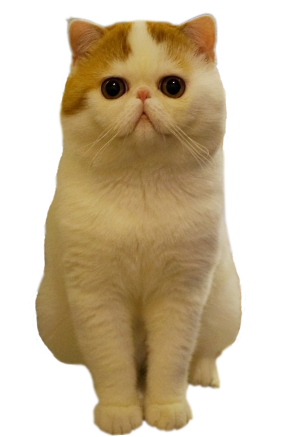Type the name of the breed you're looking for below
[wpdreams_ajaxsearchlite] Don't see the breed your're looking for? Click here and let us know!
Breed Characteristics
1 paw - breed exhibits the least amount of this characteristic
5 paws - breed exhibits most amount of this characteristic
Exotic Shorthair
| Origin And History | In the late 1950s American Shorthair breeders, motivated by the popularity of the Persian, secretly began to mix Persians into their American Shorthair bloodlines to improve body type and to introduce the beautiful and favored silver Persian color into the American. (At that time and until 1965 American Shorthairs were known as Domestic Shorthairs.) Because of this hybridization, the American Shorthair conformation went through a period of remodeling in the 1960s. The boning of the American grew heavier, the head rounder, and the nose shorter, and the coat became denser and longer. Because the Persian's conformation was popular (and still is), the hybrids did well in the shows, although they were not a recognized breed at the time. Other American Short-hair breeders, appalled at the changes occurring in the breed, became determined to disallow any Americans that showed signs of hybridization. Exotic Shorthairs might have remained illegitimate if it wasn't for the efforts of CFA judge Jane Martinke. She was the first to suggest that these hybrid American/Persian mixes should have a room of their own, rather than be allowed to rearrange the furniture in the American Shorthair's suite. The Exotic Shorthair was first accepted for Championship status by the CFA in 1967. CFA breeders were then allowed to shift their American Shorthair/Persian hybrids into the newly formed Exotic Shorthair classification. Few breeders chose to transfer their cats to the new class, however, and the breeders who did decide to work with the Exotic had a long road ahead of them. Because of the initial resistance to the new breed and because few Persian breeders would allow their cats to be used in the Exotic breeding programs, progress was very slow. At first, Exotic breeders used Burmese and Russian Blues in addition to American Shorthairs to introduce the shorthair gene. The breeders used the shorthaired breeds just often enough to keep the shorthair gene in the bloodline. As the breed began to gain in popularity, and as the gene pool grew larger, the CFA began limiting the outcrosses. |
| Personality | Some folks who don't appreciate that laid-back, mellow personality label Persians and their relatives 'furniture with fur', but in truth Exotics are playful and enjoy a good game of catching the catnip mouse between bouts of catching a few ZZZs. Because of the American Shorthair influence, Exotics are reported to be livelier than Persians, although some breeders say that the two breeds are very similar in temperament. Exotic Shorthairs have a gentle and calm personality reminiscent of the Persian, but are livelier than their long-haired ancestors. Curious and playful, they are friendly to other cats and dogs. They don’t like being left alone, and need the presence of their owner (or of voices or smells reminiscent of their owner, such as a radio). They tend to show more affection and loyalty than most breeds and make excellent lap cats. Their calm and steady nature makes them ideal apartment cats for city dwellers. Nonetheless, Exotics retain some of the energetic spark of their American Shorthair forebears and they are often capable mouse hunters. Undoubtedly, the Exotic personality is, if not identical, very much like the Persian's, quiet, loyal, sweet, and affectionate. They want to be involved in their favorite humans' lives and will quietly follow them from room to room just to see what they are doing. They also enjoy hugs and cuddles, and lavish their humans with purrs and licks of affection until the thick coat drives them away to lounge on cool kitchen linoleum or cold fireplace bricks. Fanciers point out that because of the short coat, they can spend more time playing with their Exotics than grooming them. |
Physical Attributes
| Appearance | Head: Oval, massive. Very broad skull. Rounded forehead. Round, full cheeks. Short, broad, round muzzle. Short, broad nose with pronounced stop. Strong chin. Broad, powerful jaws. Pancake. Ears: Small, rounded at the tip, not too open at the base. Widely spaced and well-furnished with hair on the inside. Eyes: Large, round, well-spaced. Pure, deep color corresponding to that of the coat (gold to copper in most varieties; green in the chinchilla and the golden; blue in the white and the colorpoint). Neck: Short and thick. Body: Medium in size, cobby, low to the ground. Broad chest. Massive shoulders. Large-boned, powerful muscles. Weight: 3,5 - 6 kilogram. Paws: Short, straight, and large. Round, large paws. Tufts of hair between the toes are desirable. Tail: Short, thick, carried low. Rounded tip. Coat: Shorthaired but slightly longer than that of other shorthaired breeds. Dense, fluffy, erect hair. All Persian colors are recognized. |
| Health | Pet insurance data from Sweden puts the median lifespan of cats from the Persian group (Persians, Chinchilla, Himalayan and Exotic) at just above 12.5 years. 76% of this group lived to 10 years or more and 52% lived to 12.5 years or more. Vet clinic data from England shows an average lifespan of 12–17 years, with a median of 14.1. Feline polycystic kidney disease (PKD). Exotic shorthairs as is the case of Persians and other Persian derived cats have a high chance of inheriting PKD, a disease that can lead to kidney failure. Several studies using ultrasound scan screening have shown that the prevalence of PKD in exotics is between 40-50% in developed nations. DNA screening for PKD is recommended for all exotic shorthair cats used in breeding programs, to reduce the incidence of kidney disease, by spaying and neutering PKD positive cats. |



